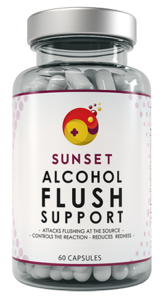
Asian Glow, an embarrassing skin reaction otherwise known as Asian Red Face, Asian Flush, Alcohol Flush Reaction and Oriental Flushing Syndrome, is a skin reaction common to many Asian people when they drink alcohol.
What is “Asian Glow” or “Asian Flush”?
Between the winter cold and the excitement of being around friends and the opposite sex, many of us get a little red in the face while drinking alcohol. But for a significant percentage of people of Asian descent, drinking too much – or even a enjoying one or two beers after work – triggers a bright red blush known as the “Asian flush.”
“It is often mistaken for a sunburn,” said my good friend who is of Japanese heritage. This is ironic as he lives in the United Kingdom, a country that only really gets 3-4 months of sun a year (the rest of the year is usually overcast or snowing/sleeting).
 “When I drink, the skin in my face and even all the way down to my waist will start to turn red. It’s kept me from ever really enjoying drinking alcohol, to be honest.”
“When I drink, the skin in my face and even all the way down to my waist will start to turn red. It’s kept me from ever really enjoying drinking alcohol, to be honest.”
This type of response is typical for about a third of people with East Asian heritage, occurring predominantly in individuals of Japanese, Chinese or Korean descent (a demographic that makes up approximately 8% of the world’s population).
Philip J. Brooks, an investigator with the Division of Metabolism and Health Affects at the National Institute on Alcohol Abuse and Alcoholism (NIAAA) describes the Asian Flush symptoms:
“People who have this will get a facial flush and a headache and will feel nauseous at the time they’re drinking. And it’s not just flushing. They’ll also get an increased heart rate. It’s a pretty unpleasant experience.”
Why do Asian people suffer from this condition?

Studies have shown that Asian flush is basically a genetic inability to properly metabolize alcohol (or ethanol) which, thanks to enzymes in the liver, is normally metabolized first into the toxic chemical acetaldehyde. Acetaldehyde, an animal carcinogen that causes DNA damage and other cancer-promoting effects is further metabolized into the harmless substance acetate.
ALDH2
People with a flushing response to alcohol have a genetic deficiency in the alcohol-metabolizing enzyme aldehyde dehydrogenase 2 or ALDH2, which can lead to an accumulation of the toxic substance acetaldehyde.
East Asians have two main variants of the ALDH2 gene — one that produces an enzyme with normal activity, and another that results in an inactive enzyme. When individuals with the inactive variant drink alcohol, acetaldehyde accumulates in the body as described above, resulting in facial flushing, nausea, and rapid heartbeat. For people with two copies of the inactive variant, these symptoms are so severe that they can drink very little alcohol.
Individuals with only one copy of the inactive variant can become tolerant to the unpleasant effects of acetaldehyde, like my Japanese friend who still drinks despite all of the side-effects as he wants to remain social with his friends and workmates. He just puts up with the unpleasant side-effects.
Are Asians allergic to alcohol?
Using the word ‘allergic’ is too simple of an explanation here. As explained above, a flushing reaction to alcohol is due to a genetic deficiency of an alcohol metabolizing enzyme that leads to acetaldehyde building up/accumulating in the body. This is different from traditional allergies where the immune system reacts abnormally to a foreign substance, usually causing some form of inflammation response.
There are some (a large portion of the population actually, many who don’t realize/misdiagnose the symptoms) who actually do suffer from allergic reactions to wine sulfites, but that is an entirely separate issue from the Asian Flush condition. A brilliant article in the Huffington Post recently uncovered that allergic reactions to alcohol may be a lot more common then we think:
Hangover symptoms can be perceived as collateral damage to a good night out, but they may actually be the result of an allergic reaction to ingredients in alcohol…
It is most likely the ingredients, such as sulfur dioxide, yeast and additives that actually cause the allergic reaction and lead you to feel less than perfect.
Here are some ingredients in alcohol that can cause a reaction:
- Gluten and Wheat
- Histamine
- Sulfur Dioxide or Sulfites
- Yeast
- Grape Allergies
- Tree Nut Allergies
Read the full article on alcohol allergies here.
Risks of cancer for people with ALDH2 deficiency
Looking into this further after hearing my friends obvious discomfort, it became apparent that there are fatal risks of esophageal cancer when people with an ALDH2 deficiency drink alcohol:
“Anyone who drinks is at risk, but the more you drink, the more your risk goes up. And when you’re ADLH2-deficient, your risk goes up much more dramatically.”
Studies are showing that a person with a single copy of the deficient ALDH2 gene who drinks just two beers a day is up to 10 times more likely to develop esophageal cancer than a person who’s able to metabolize the alcohol properly. That’s a scary number!
The upside of this is that there is a lower than average rate of alcoholism among those of East Asian descent, likely due to its association with adverse effects after drinking alcohol.
BREAKING NEWS: Do you suffer from Asian Flush Reaction to alcohol? Check out the Sunset Asian Flush Cure supplement…
We have partnered with experts in the Asian Flush space + spent months researching and developing the most effective cure. Finally, we beta tested our solution with a select audience.
Following all this hard work, we started a crowd funding campaign on IndieGoGo to bring our solution to market.
That crowdfunding campaign was extremely successful, raising over 316% of the funding goal!
If you are still looking for an effective cure for Asian flush, you can now pre-order Sunset Alcohol Flush Support on the website:
Buy Sunset Asian Flush Cure Today…
Similar Conditions
Asian flush often gets confused with other medical conditions, including:
- Rosacea: is a chronic facial skin condition in which capillaries are excessively reactive which leads to redness in the skin from flushing.
- Degreaser’s flush: arises after consuming alcohol shortly before or during inhalation of trichloroethylene (TCE), an organic solvent with suspected carcinogenic properties.
- Carcinoid syndrome: episodes of severe flushing precipitated by alcohol, stress and certain foods. Also (usually) leads to diarrhea, wheezing and weight loss.
- Red ear syndrome: thought by many to be triggered by alcohol.
Asian Flush Cure

There are a few common solutions to the Asian glow problem that have arisen lately. The best current advice for those suffering from flushing when drinking alcohol is pretty simple but you should know the the pros and cons before using, so we have laid out both below. Please note: this is not medical advice and we (Sobur) can’t take responsibility for any effects caused by following these points. Please do your own research and consult with a medical expert before following any of this up:
Take antihistamine’s (specifically H2-antagonists like Pepcid AC & Zantac) before consuming alcohol
The science behind this is not solid, as I couldn’t find any definitive scientific studies backing up the theory, but according to a few individuals I asked who have suffered from asian glow and successfully managed to cure it, over the counter heartburn medications like Pepcid and Zantac can help reduce symptoms significantly if taken before consuming alcohol.
Antihistamines that are specifically H2-antogonists are recommended. H2 receptors are found in the parietal cells of the stomach, where it induces acid secretion. By blocking histamine activity in the stomach, H2-antagonists can help treat heartburn or gastric ulcers (there are other types of ‘antacids’ like Prilosec and Tums, but these act on different mechanisms).
As we explained above, ‘asian glow‘ is the result of enzyme differences that lead to accumulation of acetaldehyde, a metabolic byproduct of ethanol (alcohol). Acetaldehyde induces flushing through histamine release. H2 receptors are also found in vascular smooth muscle, where it mediates vasodilation. By blocking histamine receptors, H2 antagonists can effectively reduce flushing.
Don’t forget the risk of consuming alcohol with an ALDH2 deficiency
I have to sign off this asian flush cure guide by re-highlighting the genuine risk behind continuing to drink alcohol despite an ALDH2 deficiency (aka regular suffering from alcohol flush). As mentioned by Philip J. Brooks, an investigator with the Division of Metabolism and Health Affects at the NIAAA (NIAAA), many people of Asian descent are familiar with the flush, but too few realize it’s not just an inconvenience, but a red flag for one of the deadliest cancers worldwide (esophageal cancer).
“It’s not just an issue that affects appearance, but an indication that they’re at increased risk of esophageal cancer if they drink heavily, You have to think about the production of acetaldehyde throughout the body. We want people to discuss this with their doctor and be sure their doctor is aware of the data that’s out there.”

